Related Research Articles
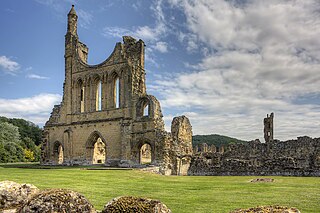
Byland Abbey is a ruined abbey and a small village in the Ryedale district of North Yorkshire, England, in the North York Moors National Park.
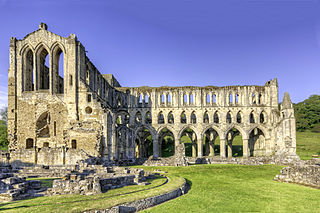
Rievaulx Abbey was a Cistercian abbey in Rievaulx, near Helmsley, in the North York Moors National Park, North Yorkshire, England. It was one of the great abbeys in England until it was seized in 1538 under Henry VIII during the Dissolution of the Monasteries. The wider site was awarded Scheduled Ancient Monument status in 1915 and the abbey was brought into the care of the then Ministry of Works in 1917. The ruins of its main buildings are today a tourist attraction, owned and maintained by English Heritage.
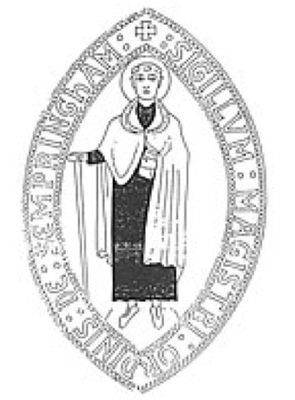
The Gilbertine Order of Canons Regular was founded around 1130 by Saint Gilbert in Sempringham, Lincolnshire, where Gilbert was the parish priest. It was the only completely English religious order and came to an end in the 16th century at the time of the Dissolution of the Monasteries. Modest Gilbertine revivals have taken place in the late 20th and early 21st centuries on three continents.
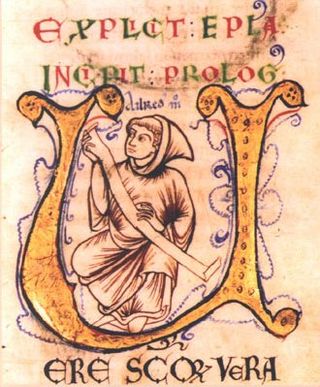
Aelred of Rievaulx, O Cist. ; also Ailred, Ælred, and Æthelred; was an English Cistercian monk, abbot of Rievaulx from 1147 until his death, and known as a writer. He is venerated by the Catholic Church as a saint and by some Anglicans.

This article presents lists of the literary events and publications in the 12th century.
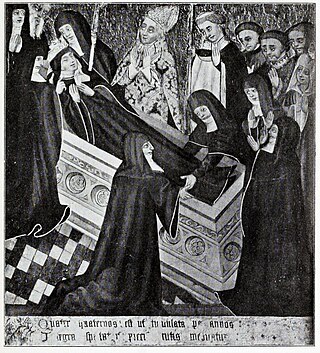
Seaxburh, also Saint Sexburga of Ely, was a Queen as well as an abbess, and is a saint of the Christian Church. She was married to King Eorcenberht of Kent.
The Nun of Watton was a young nun at Watton Priory in Yorkshire who, according to an account recorded by St Aelred of Rievaulx around 1160 in De Quodam Miraculo Mirabili, long known as De Sanctimoniali de Wattun., was impregnated by a young friar and miraculously cleansed of sin.
Watton is a village and civil parish in the East Riding of Yorkshire, England. The village is situated on the A164 road, about 6 miles (9.7 km) north of Beverley and 6 miles (9.7 km) south of Driffield.

Rosedale Abbey is a village in the Ryedale district of North Yorkshire, England. It is approximately 8 miles (13 km) north-west of Pickering, 8 miles south-east of Castleton and within Rosedale, part of the North York Moors National Park.

Roskilde Abbey or Our Lady's Abbey, Roskilde, was a nunnery dedicated to Saint Mary the Virgin. The abbey was located at Roskilde on the Danish island of Zealand. It was founded in the early 12th century for Benedictine nuns, but in 1177 became part of the Cistercian reform movement. The abbey was suppressed in 1536 during the Protestant Reformation in Denmark. It is now the site the Old Church of Our Lady, Roskilde .
Relatio de Standardo, or De bello standardii, is a text composed probably in 1153 or 1154 by the Cistercian monk Aelred of Rievaulx, describing the Battle of the Standard, fought near Northallerton in 1138 between David I, King of Scotland, and a Norman army fighting in support of King Stephen of England.
The Vita Sancti Niniani or simply Vita Niniani is a Latin language Christian hagiography written in northern England in the mid-12th century. Using two earlier Anglo-Latin sources, it was written by Ailred of Rievaulx seemingly at the request of a Bishop of Galloway. It is loosely based on the career of the early British churchman Uinniau or Finnian, whose name through textual misreadings was rendered "Ninian" by high medieval English and Anglo-Norman writers, subsequently producing a distinct cult. Saint Ninian was thus an "unhistorical doppelganger" of someone else. The Vita tells "Ninian's" life-story, and relates ten miracles, six during the saint's lifetime and four posthumous.
Eustace fitz John, Constable of Chester, was a powerful magnate in northern England during the reigns of Henry I, Stephen and Henry II. From a relatively humble background in South East England, Eustace made his career serving Henry I, and was elevated by the king through marriage and office into one of the most important figures in the north of England. Eustace acquired a great deal of property in the region, controlled Bamburgh Castle, and served jointly with Walter Espec as justiciar of the North.

Vallbona Abbey, otherwise the Monastery of Santa Maria de Vallbona, is a Cistercian nunnery in Vallbona de les Monges, in the comarca of Urgell, Catalonia, Spain. Founded in the early 12th century, and built between then and the 14th century, it is one of the most important monastic sites in Catalonia. Its church represents an example of transition between Romanesque and Gothic architecture. The abbey was declared a national monument on 3 June 1931.

Swine Priory was a priory in the village of Swine in the East Riding of Yorkshire, England. The site of the Cistercian nunnery is a Scheduled Monument.

Watton Priory was a priory of the Gilbertine Order at Watton in the East Riding of Yorkshire, England. The double monastery was founded in 1150 by Eustace fitz John.

Ellerton Priory was a priory of Cistercian nuns in Swaledale in North Yorkshire, England. Its ruins lie in the civil parish of Ellerton Abbey.

Esholt Priory was a Cistercian priory in West Yorkshire, England which was sold after the Dissolution of the Monasteries, and the present Grade II* listed Esholt Hall now stands on the site of the priory.

The Keldholme Priory election dispute occurred in Yorkshire, England, in 1308. After a series of resignations by its prioresses, the establishment was in a state of turmoil, and the Archbishop of York, William Greenfield, appointed one of the nuns to lead the house. His candidate, Emma de Ebor', was deemed unacceptable by many nuns, who undermined her from the start to the extent that she resigned three months later. The archbishop, forced to find another candidate, claimed that he was unable to do so from within the priory and appointed Joan de Pykering from nearby Rosedale Priory. It is likely that Keldholme saw de Pykering as an intruder, and it seems to have reacted against her in much the same way as to her predecessor.
References
- Dutton (2006). "Introduction". In Freeland, Jane Patricia; Dutton, Marsha L. (eds.). Aelred of Rievaulx: The Lives of the Northern Saints. Cistercian Father's Series: Number Seventy-One. Kalamazoo, Michigan: Cistercian Publications. ISBN 0-87907-471-X.